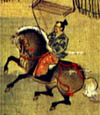
|
|
|
page
2
|
selected information |
|
The story of Knitting in Japan, Part 1 |
|||
| Before the Europeans, continued | |||
|
More substantial articles remain from the Kamakura period
(1185-1333). This was the period during which Buddhism and Zen became
a major force in Japanese culture, and significant textile remains can
be found at the Buddhist temples at Kankiko-ji in Kyoto and the ‘Jishu’
sect temples in the Aichi, Nagano, Kanagawa and Yamagata prefectures.
Matushita again uses the term ‘knitting’ to describe the soldier’s leg-protectors (Habaki) made from Karamushi (a material similar to linen) and the Buddhist costume worn by the priest Ippen-shonin ‘knitted’ from yucca vine. The technique used to make this costume was the same method used to make ‘Tawara’ (straw bags used for keeping farm products). |
 |
||
|
Mr Matushita is probably not really saying that these
examples of Japanese indigenous textiles are knitting as we know it today,
but that they use somewhat analogous techniques, such as naalbinding,
in common with the artefacts of many other indigenous peoples.
|
Ippen-shonin | ||
|
The earliest known examples of the structure that we recognise as knitting today, sometimes called open-loop knitting, are hotly debated. The socks made by the Coptic people around 3 AD are now also considered to be naalbinding. It is generally accepted that knitting may have started in Arabia and passed to Europe through Egypt. Similarly, the exact period when today’s style of knitting arrived in Japan is shrouded in uncertainty, even although it must have followed on from contacts with Europeans. We know that knitting with needles was already being practised in Italy during the thirteenth century, and that the practice had spread widely during the following centuries. By 1589 the English priest, William Lee, was so concerned to help ease his wife’s knitting labours that he invented the first knitting machine..... |
|||
| >> page 3 | |||